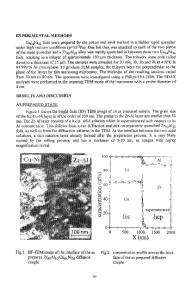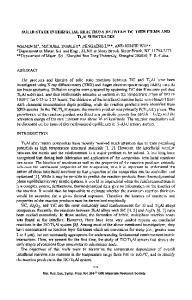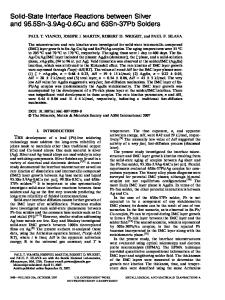Solid state reactions between Ni 3 Al and SiC
- PDF / 1,257,014 Bytes
- 10 Pages / 593.28 x 841.68 pts Page_size
- 54 Downloads / 389 Views
Ordered intermetallic compounds, such as nickel-, titanium-, iron-, or niobium-aluminides, are well known for their good oxidation and environmental resistance, high melting point, and relatively low density.1 They are promising candidates for advanced aerospace applications. However, these materials possess poor ductility at low temperatures, and low strength at high temperatures.1 By incorporating 30-50 vol. % high strength continuous fibers, the high temperature strength and toughness of such intermetallic matrix composites can be improved. A recent work1 demonstrated that, during high temperature creep testing, more than 90% of the load was carried by the fibers in a relatively weak matrix. Furthermore, the incorporation of high volume percentage of fibers significantly reduces the weight of composites, which in turn gives rise to higher thrust/weight ratios. This is beneficial to aeropropulsion applications. An important issue to be addressed in a composite material is the chemical and thermal compatibility (i.e., interfacial reactions), in addition to the thermal expansion coefficient match, between the matrix and reinforcement. A chemical interaction between the reinforcement and matrix is desired from a metallurgical bonding point of view. Nevertheless, the interaction causes consumption of the reinforcement and forms new phases at the interface. Those reaction-formed interfacial phases are usually of compound form and J. Mater. Res., Vol. 5, No. 9, Sep 1990
http://journals.cambridge.org
Downloaded: 24 Mar 2015
are brittle in nature, which in turn degrade the overall mechanical properties of the composites. The matrix/ reinforcement interactions deserve special attention in intermetallic matrix composites due to the high temperature nature during the composite consolidation and engineering applications. Recently, it was reported2 that three reaction layers, as opposed to four reaction layers,3 were formed between the SiC and Ni3Al after 4 h annealing at 1000 °C in a He ambient. A few intriguing results were noted: (1) the formation of modulated carbon bands in the Ni,AlySiz layer; (2) the formation of a carbon-depleted NixAlySi; layer; (3) the formation of an Al-rich nickel aluminide layer. Based on a Ni-Al binary phase diagram,4 thermodynamic phase rules, and atomic concentration calculation from two available Ni-Al-Si ternary compounds, the formation of NiAl and Ni(Al0.5Si0.5) phases, which correspond to the Al-rich nickel aluminide and C-depleted Ni^Al^Siz layers, respectively, was suggested. In the present work, we carried out detailed studies to determine the chemistry of the reaction product and to understand the mechanism of NiAl formation. A new Ni5.4AliSi2 ternary phase was identified and reported. II. EXPERIMENTAL PROCEDURES
The SiC plates (1" x 1" x 1/16") were made by hot press, and purchased from Carborundum Corp. Their density is about 99.5% of the theoretical one. By x-ray diffraction, the SiC is found to be primarily the 1985
© 1990 Materials Research Society
IP address: 141.217.58.200
Data Loading...











